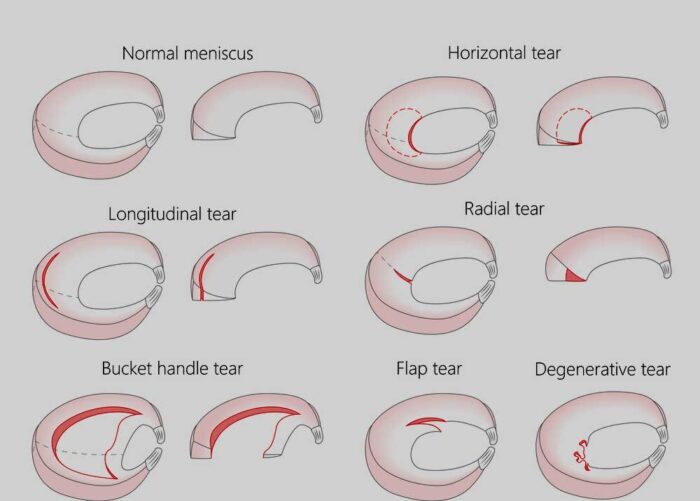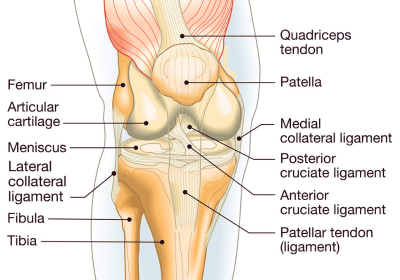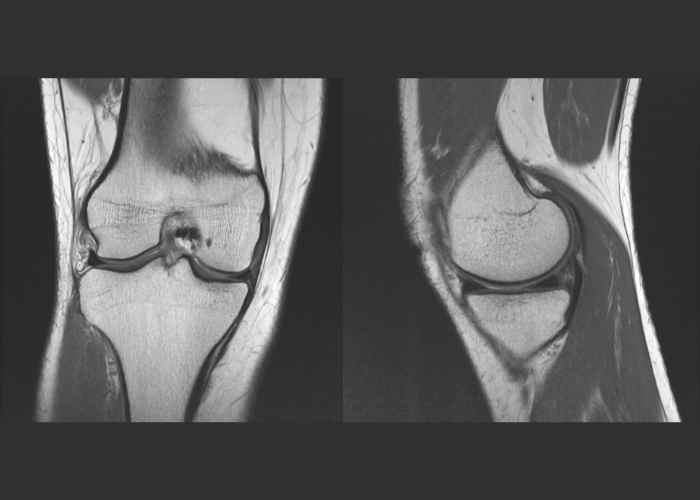Meniscus Tear Specialist
Do you have knee pain that’s getting worse? Does your knee click or pop when you bend it? You may have a meniscus tear. Meniscus tear specialist Dr. Prem N. Ramkumar provides non-surgical and surgical treatments for patients with a meniscus tear. His office is located in Long Beach and he serves Los Angeles, Orange County, and surrounding Southern California areas. Contact Dr. Ramkumar’s team for an appointment today!

What is a meniscus Tear?
A meniscus tear is one of the most common injuries affecting the knee and can occur in both athletes and non-athletes.
The menisci are strong, rubbery, wedge-shaped discs of cartilage in the knee that act as shock absorbers between the femur (thigh) bone and tibia (shin). The inner meniscus also helps keep the knee stable, while the outer meniscus allows it to move smoothly. Each knee has two menisci:
- Lateral meniscus – handles 80% of the load applied to the outside of the knee joint
- Medial meniscus – handles 50% of the load applied to the inside of the knee joint
A meniscus tear can be mild or severe. It can split in half, rip around its circumference, or be left hanging by a thread to the knee joint. Contrary to popular belief, most meniscus “repair” surgeries actually involve removing a piece of nonfunctional tissue rather than sewing it back. Meniscus repair is best performed in the setting of specific tear patterns and younger patient populations whereby the meniscus has the best environment to heal. When a meniscus does not heal after a repair, this tissue is eventually removed with a subsequent operation. Thus, it is important to balance the desire to repair every meniscus tear with minimizing the risk of reoperation. Dr. Prem N. Ramkumar, meniscus tear specialist is located in Long Beach and serves the Los Angeles, Orange County, and surrounding Southern California areas.

How does a meniscus tear occur?
A meniscus tear can occur with any activity that causes a forceful twist or rotation of the knee.
Due to its location within the knee, a medial meniscus tear is more common than a lateral meniscus tear. You are more likely to tear your meniscus if you play a contact sport, but anyone can also suffer a meniscus tear due to wear and tear on the knee joint.
What are the types of meniscus tears?
There are three areas where a meniscus tear can occur, the red zone, red-white zone, and the white zone. The outer third of the meniscus, the red zone, is an area of the cartilage with a blood supply and has a better chance of healing when repaired. The white zone is located in the inner third of the meniscus and has no blood flow. The red-white zone is the third between the red and white zones that has questionable healing potential. The zone of injury is one factor that determines the likelihood of success after meniscus removal or repair in the setting of a tear.
If you are diagnosed with a meniscus tear, Dr. Ramkumar will classify the tear based on the tear’s size, shape, and location. Types of meniscus tears include:
- Radial Tear – The most common type of tear, occurring in the white zone
- Horizontal Tear – Runs along the curved fibers of the meniscus.
- Complex Tear – Usually comprised of a radial and horizontal tear.
- Bucket-handle Tear – This tear occurs in the center of the meniscus and looks like the handle of a bucket.
- Fasciculus tear – When the meniscus tears or pulls away from the knee joint capsule.

What are the symptoms of a meniscus tear?
If you have a small meniscus tear, you can often walk, sit and stand without pain, but left untreated, a tear can increase in size and lead to more complications. Meniscus tear symptoms include:
- Sudden and severe pain if the tear occurs during trauma
- Gradual and constant pain if the tear occurs over time
- Swelling, stiffness, and inability to straighten or bend the knee
- A feeling of instability in the knee
- Clicking or snapping sound when moving the knee
How is a meniscus tear diagnosed?
The best diagnostic tool for a meniscus tear is an MRI Scan. During your appointment, Dr. Ramkumar will also obtain a detailed history and determine what led to the injury. He will also conduct a full knee assessment that may include:
- McMurray’s Test – Dr. Ramkumar moves the knee in a specific way while applying pressure
- Thessaly test – Dr. Ramkumar may ask you to perform a single leg squat on your affect leg to evaluate your pain pattern
Some meniscal tears are difficult to diagnose – especially if they are at the edge of the meniscal tissue.
What are the treatment options for a meniscus tear?
Treatment options vary for each person, depending on age, activity level, and medical history. Dr. Ramkumar also considers the size, location, and type of meniscus tear.
Non-Surgical Treatment:
If the meniscus tear is small and within the ‘red zone’ with a rich blood supply, it can heal with a combination of rest, NSAIDs (anti-inflammatory drugs), and physical therapy. Dr. Ramkumar may also recommend a hyaluronic acid or corticosteroid injection to decrease pain and swelling.
Surgical Treatment:
If non-surgical treatments do not alleviate pain, or the meniscus tear is in an area with no blood supply, a surgical repair may be necessary. Dr. Ramkumar may perform one or more of the following minimally invasive arthroscopic procedures:
- Meniscal repair: sutures are used to sew the torn meniscus together
- Meniscectomy: removes the unrepairable meniscus; this is the most common meniscus surgery performed globally
The recovery time from meniscus surgery differs from person to person and Dr. Ramkumar will review this with you. If your meniscus is repaired, you will limit weight bearing initially to provide the meniscus opportunity to heal. If the meniscus is removed, you may bear weight immediately.
Selecting an orthopedic hip surgeon with experience performing meniscus repair is crucial to a positive outcome. Dr. Prem Ramkumar is located in Long Beach and serves patients in Los Angeles, Orange County, and surrounding Southern California areas.



